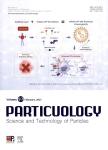DEM analysis of the influence of stirrer design on die filling with forced powder feeding
作者机构:School of Chemistry and Chemical EngineeringUniversity of SurreyGuildfordGU2 7XHUnited Kingdom Small Molecule PharmaceuticsGenentechInc.One DNA WaySouth San FranciscoCA94080USA
出 版 物:《Particuology》 (颗粒学报(英文版))
年 卷 期:2024年第88卷第5期
页 面:107-115页
核心收录:
学科分类:080706[工学-化工过程机械] 08[工学] 0807[工学-动力工程及工程热物理]
基 金:the financial support from Genentech Ltd.,the Engineering and Physical Science Research Council(Grant No.EP/M02976X) the Marie Skłodowska-Curie Individual Fellowships under European Union's Horizon 2020 research and innovation programme(Grant No.840264)
主 题:Discrete element method Die filling Forced feeding Stirrer design GPU computing
摘 要:Die filling is a critical stage during powder compaction,which can significantly affect the product quality and *** this paper,a forced feeder is introduced attempting to improve the filling performance of a lab-scale die filling *** die filling process is analysed with a graphics processing units(GPU)enhanced discrete element method(DEM).Various stirrer designs are assessed for a wide range of process settings(i.e.,stirrer speed,filling speed)to explore their influence on the die filling performance of free-flowing *** results show that die filing with the novel helical-ribbon(i.e.,type D)stirrer design exhibits the highest filling ratio,implying that it is the most robust stirrer design for the feeder configuration ***,die filling performance with the type D stirrer design is a function of the stirrer speed and the filling speed.A positive variation of filling ratio(ηf0%)can be ensured over the whole range of filling speed by adjusting the stirrer speed(i.e.,increasing the stirrer speed).The approach used in this study can not only help understand how the stirrer design affects the die filling performance but also guide the optimization of feeder system and process settings.




